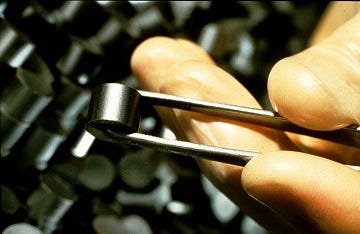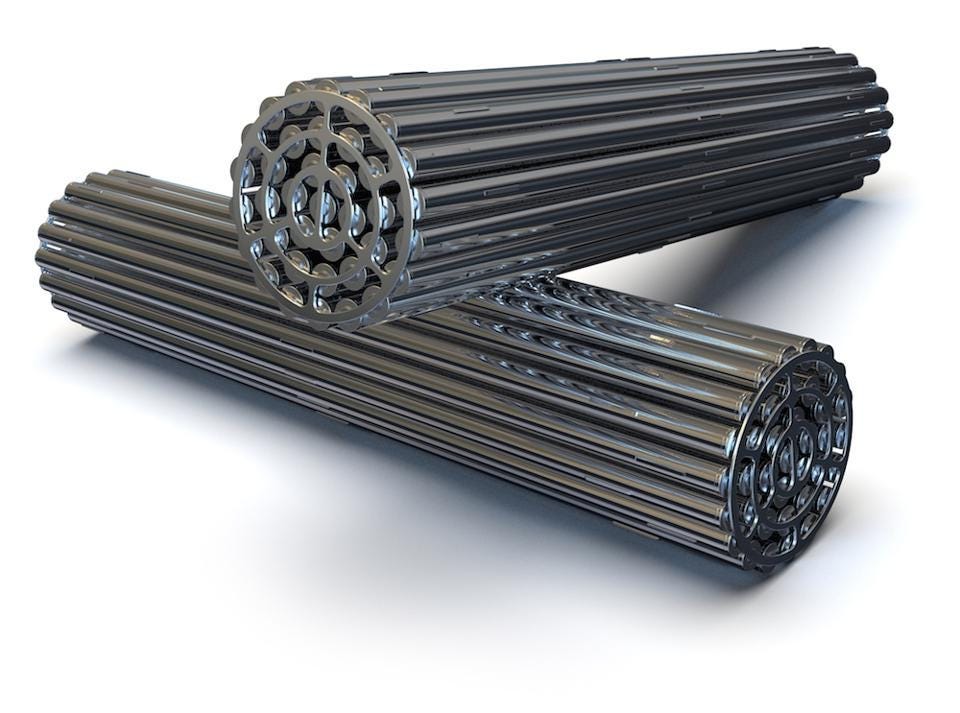Nuclear Power and Hot Air Balloons
Visualizing the amount of CO2 averted by nuclear reactors
In environmental discussions the quantities of pollutant involved are very difficult to visualize. What does a ton of carbon dioxide look like? Nobody knows. It’s a clear gas and the sky is huge so what does that even mean to our primate brains? Nothing.
HWFO likes to play with arbitrary units, like the time we visualized the costs of different government programs in the unit of “Trump Border Walls,” and I think this technique could be very instructive in comparing the differential pollutant loads of nuclear and coal power generation. This is easy and quick, so let’s just knock it out.
Uranium
Nuclear fuel rods are made by squeezing refined uranium into tiny pellets, and embedding them in rods. One single pellet produces about the same amount of energy as one ton of coal does when it’s burned. The pellets are around a half an inch across, and look like this:
That little thing is a ton of coal. There are 300 of those in each rod, so each rod spent in electricity generation averts 300 tons of coal being burned. The rods are then bundled and used in reactors to generate heat. The bundles, called fuel assemblies, are about a half a meter long and a tenth of a meter wide, and look like this:
Each one of the individual rods inside each of those 37 rod bundles averts 300 tons of coal being burned. But what does that mean for actual CO2 emissions?
Coal
A ton of coal burned doesn’t produce a ton of carbon dioxide, because of chemistry, and stoichiometry, and power plant efficiency, and lots of other funny math besides. Burning a single ton of coal releases 5,720 pounds of carbon dioxide, which means using our single uranium fuel rod in replacement averts one million seven hundred sixteen thousand pounds of CO2 being released into the atmosphere.
But again, we’re up against our unit visualization problem. Our puny primate minds don’t know what 1,716,000 pounds of carbon dioxide looks like, when we stare into the sky, because the sky is very large and our minds really don’t properly grok the “weight of a gas.” Shoot, hot air balloons are full of gas, and they seem to us to be weightless. So let’s adjust our perception by turning our weight of CO2 into a volume. There are 8.566 cubic feet of volume per pound of CO2, which looks about like this:
The true volume varies by it’s pressure and temperature according to the Ideal Gas Law, but let’s skip that for now. This still doesn’t help us visualize, though, because copying that image over and over 1,716,000 times wouldn’t appease our sense of scale either. Bring back the balloons!
Hot Air Balloons
There are around 77,550 cubic feet of air in a typical inflated hot air balloon. This means generating energy from one nuclear control rod, a single rod within the 37 rod bundle shown above, averts 190 hot air balloons worth of CO2 emissions. The largest hot air balloon festival in the world is the Albuquerque International Balloon Fiesta, which in 2021 had 600 balloons at it. We can visualize that.
The balloon festival grounds are shown fairly clearly in that second image. It appears they probably stagger people’s balloon launches so they don’t end up with any dangerous high speed balloon collisions, but imagine that field completely packed with balloons, and you have a sense of what 3.1 control rods worth of CO2 looks like. Two full fuel assemblies, as shown in the second picture of this article, is equivalent to approximately twenty three Albuquerque International Balloon Festivals worth of CO2, about two per month for a whole year.
Choose Your Pollutant
I do not make any claim in this article that one set of waste is worse than another set of waste. If we wanted to try and evaluate that, we would first have to figure out how much global warming would be averted by not releasing 23.37 Albuquerque Balloon Festivals worth of CO2 into the air, which it turns out isn’t that much. Obama’s much lauded 2014 eight billion dollar climate plan would only avert 0.02 degrees Celsius worth of warming, according to the EPA’s own modeling. If Obama spent those eight billion dollars on the World Land Trust website he could have preserved in perpetuity 80 million acres of rainforest, a land area slightly larger than the entire country of Ecuador. Given how South American countries are slashing and burning their own rainforests for economic reasons, that seems like a better deal than almost literally anything else we could do. Cynically, I think the reason we spend so much money on carbon sequestration technology while letting the rain forests burn is that the rain forests don’t have highly paid DC lobbyists with a potential return on investment.
Disposing of spent nuclear fuel is indeed problematic, but is it as problematic as carbon? Hard to say. Is mining coal more damaging to the environment than mining uranium? I don’t know. But given how countries who are less stupid than the USA recycle their spent fuel rods, the net pollution from nuclear (barring accidents) can be effectively zero provided you have the will to do so as a people.
It seems to me that if pollution is one of your concerns, the visualizations in this article may be helpful, and if you find them helpful, consider sharing them.










Great post! For us American readers, I would add that those fuel rod bundles measured in meters are only 4”x20” cylinders. CDs or DVDs are 5” across, and 20” is about knee high to a 6’ tall man. So even if the airspace in those rods assemblies are left when storing, all that is in a space significantly smaller than a stack of cds that reaches the knee of an adult male.
Is it really that hard to visualize? A ton of coal produces 1,716,000 lb CO2, at 8.566 cu ft/lb. That's 14,699,256 cu ft at standard pressure and temperature. That's a cube 244.96 feet on a side, roughly 81 2/3 yards. With 77,500 cu ft hot air per balloon, that 14.7M cu ft works out to only 190 balloons, the last one only 2/3 inflated (189.65). All of this is for a single ton of coal. Those 2 fuel rods have 37 rods each and each rod is equivalent to 300 tons of coal. So that's equivalent to 22,200 tons of coal, which equates to 4,210,230 balloons. At 600 balloons per festival, that's 7017.05 festivals. Quite a few more than your numbers, but my math could be wrong.
On the other hand, 22,200 tons of coal generates 326.3 billion cu ft CO2, which is a little over 2.2 cubic miles worth. One of these Climate Change sites calculates that humanity puts 4,400 cubic kilometers of CO2 to the atmosphere every year, which is 1055 cubic miles. This is equivalent to 500 pairs of your control rods.
Clearly, nuclear power is the only way to go.